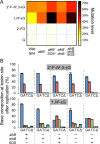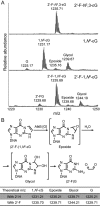Next-generation sequencing reveals the biological significance of the N(2),3-ethenoguanine lesion in vivo
- PMID: 25837992
- PMCID: PMC4477646
- DOI: 10.1093/nar/gkv243
Next-generation sequencing reveals the biological significance of the N(2),3-ethenoguanine lesion in vivo
Abstract
Etheno DNA adducts are a prevalent type of DNA damage caused by vinyl chloride (VC) exposure and oxidative stress. Etheno adducts are mutagenic and may contribute to the initiation of several pathologies; thus, elucidating the pathways by which they induce cellular transformation is critical. Although N(2),3-ethenoguanine (N(2),3-εG) is the most abundant etheno adduct, its biological consequences have not been well characterized in cells due to its labile glycosidic bond. Here, a stabilized 2'-fluoro-2'-deoxyribose analog of N(2),3-εG was used to quantify directly its genotoxicity and mutagenicity. A multiplex method involving next-generation sequencing enabled a large-scale in vivo analysis, in which both N(2),3-εG and its isomer 1,N(2)-ethenoguanine (1,N(2)-εG) were evaluated in various repair and replication backgrounds. We found that N(2),3-εG potently induces G to A transitions, the same mutation previously observed in VC-associated tumors. By contrast, 1,N(2)-εG induces various substitutions and frameshifts. We also found that N(2),3-εG is the only etheno lesion that cannot be repaired by AlkB, which partially explains its persistence. Both εG lesions are strong replication blocks and DinB, a translesion polymerase, facilitates the mutagenic bypass of both lesions. Collectively, our results indicate that N(2),3-εG is a biologically important lesion and may have a functional role in VC-induced or inflammation-driven carcinogenesis.
© The Author(s) 2015. Published by Oxford University Press on behalf of Nucleic Acids Research.
Figures







Similar articles
-
Molecular dosimetry and repair of N(2),3-ethenoguanine in rats exposed to vinyl chloride.Cancer Res. 2002 Sep 15;62(18):5189-95. Cancer Res. 2002. PMID: 12234983
-
Insights into the Direct Oxidative Repair of Etheno Lesions: MD and QM/MM Study on the Substrate Scope of ALKBH2 and AlkB.DNA Repair (Amst). 2020 Dec;96:102944. doi: 10.1016/j.dnarep.2020.102944. Epub 2020 Sep 9. DNA Repair (Amst). 2020. PMID: 33161373 Free PMC article.
-
Model calculations for the misincorporation of nucleotides opposite five-membered exocyclic DNA adduct: N(2),3-ethenoguanine.J Phys Chem B. 2011 Sep 8;115(35):10537-46. doi: 10.1021/jp202738v. Epub 2011 Aug 11. J Phys Chem B. 2011. PMID: 21776999
-
Enzymology of repair of etheno-adducts.Mutat Res. 2003 Oct 29;531(1-2):219-29. doi: 10.1016/j.mrfmmm.2003.07.008. Mutat Res. 2003. PMID: 14637257 Review.
-
Lipid peroxidation in face of DNA damage, DNA repair and other cellular processes.Free Radic Biol Med. 2017 Jun;107:77-89. doi: 10.1016/j.freeradbiomed.2016.11.043. Epub 2016 Nov 28. Free Radic Biol Med. 2017. PMID: 27908783 Review.
Cited by
-
The AlkB Family of Fe(II)/α-Ketoglutarate-dependent Dioxygenases: Repairing Nucleic Acid Alkylation Damage and Beyond.J Biol Chem. 2015 Aug 21;290(34):20734-20742. doi: 10.1074/jbc.R115.656462. Epub 2015 Jul 7. J Biol Chem. 2015. PMID: 26152727 Free PMC article. Review.
-
Mechanisms of DNA-reactive and epigenetic chemical carcinogens: applications to carcinogenicity testing and risk assessment.Toxicol Res (Camb). 2018 Dec 18;8(2):123-145. doi: 10.1039/c8tx00250a. eCollection 2019 Mar 1. Toxicol Res (Camb). 2018. PMID: 30997017 Free PMC article. Review.
-
Mass spectrometry-based assays for assessing replicative bypass and repair of DNA alkylation in cells.RSC Adv. 2023 May 22;13(23):15490-15497. doi: 10.1039/d2ra08340j. eCollection 2023 May 22. RSC Adv. 2023. PMID: 37223415 Free PMC article. Review.
-
Etheno adducts: from tRNA modifications to DNA adducts and back to miscoding ribonucleotides.Genes Environ. 2021 Jun 16;43(1):24. doi: 10.1186/s41021-021-00199-x. Genes Environ. 2021. PMID: 34130743 Free PMC article. Review.
-
7,8-Dihydro-8-oxo-1,N6-ethenoadenine: an exclusively Hoogsteen-paired thymine mimic in DNA that induces A→T transversions in Escherichia coli.Nucleic Acids Res. 2022 Apr 8;50(6):3056-3069. doi: 10.1093/nar/gkac148. Nucleic Acids Res. 2022. PMID: 35234900 Free PMC article.
References
-
- Abdulla F.R., Feldman S.R., Williford P.M., Krowchuk D., Kaur M. Tanning and skin cancer. Pediatr. Dermatol. 2005;22:501–512. - PubMed
-
- Wogan G.N. Dietary factors and special epidemiological situations of liver cancer in Thailand and Africa. Cancer Res. 1975;35:3499–3502. - PubMed
-
- Triantafillidis J.K., Nasioulas G., Kosmidis P.A. Colorectal cancer and inflammatory bowel disease: epidemiology, risk factors, mechanisms of carcinogenesis and prevention strategies. Anticancer Res. 2009;29:2727–2737. - PubMed
Publication types
MeSH terms
Substances
Grants and funding
- P30 ES000267/ES/NIEHS NIH HHS/United States
- P01 CA160032/CA/NCI NIH HHS/United States
- R01 GM069857/GM/NIGMS NIH HHS/United States
- T32 ES007020/ES/NIEHS NIH HHS/United States
- P30 ES002109/ES/NIEHS NIH HHS/United States
- R37 CA080024/CA/NCI NIH HHS/United States
- P01 ES005355/ES/NIEHS NIH HHS/United States
- P01 ES05355/ES/NIEHS NIH HHS/United States
- Howard Hughes Medical Institute/United States
- P30 CA068485/CA/NCI NIH HHS/United States
- P01 CA026731/CA/NCI NIH HHS/United States
- R01 CA080024/CA/NCI NIH HHS/United States
- S10 RR019022/RR/NCRR NIH HHS/United States
- R01 ES010546/ES/NIEHS NIH HHS/United States
LinkOut - more resources
Full Text Sources
Other Literature Sources
Molecular Biology Databases

